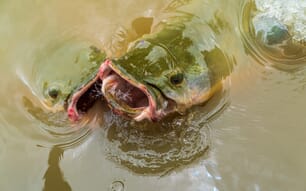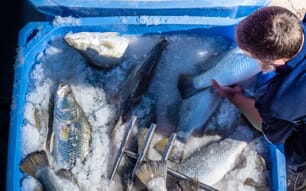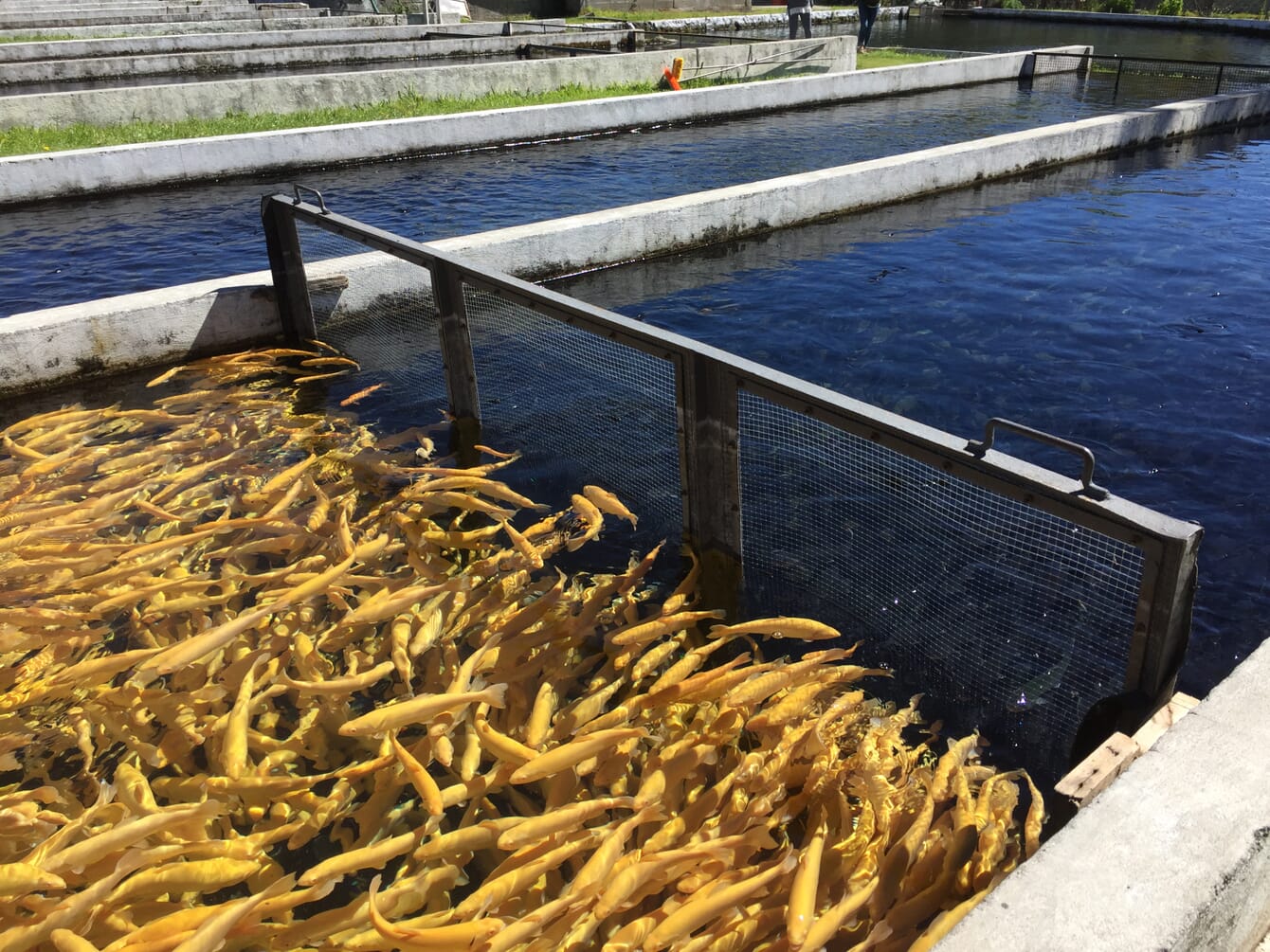
Making the most efficient use of a production system’s capacity is a key consideration for aquaculturalists
Stocking and harvesting strategies have a significant impact on productivity and profitability within most aquaculture enterprises. Depending on the production system and the species being raised, wrong approaches to stocking and harvesting can ultimately lead to economic failure. Profitable strategies are based on the biological requirements and characteristics of the species being cultured, as well as the carrying capacity and performance of the production system being utilised.
Making the most efficient use of a production system’s capacity is a key consideration in the development of stocking and harvesting strategies. Every production system has a limit to the amount of standing stock it can support.
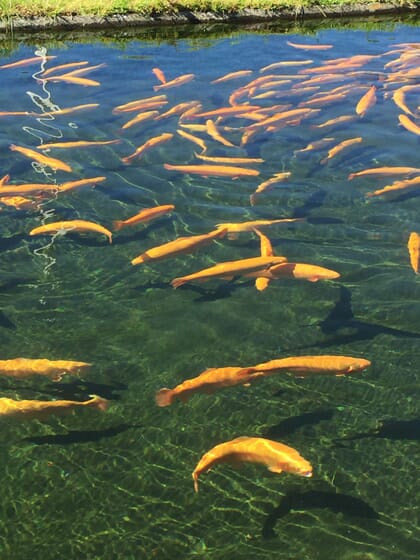
A pond is limited by the amount of feed inputs (and associated waste products) that it can adequately assimilate and break down
A pond is ultimately limited by the amount of feed inputs (and associated waste products) that it can adequately assimilate and break down through natural processes. This limit may be increased by supplemental aeration, or water exchange rates under some circumstances, but it will nevertheless dictate the total amount of standing stock that can be maintained in the pond at any given time.
In raceways, cage culture, or recirculating systems, limiting factors may involve aeration systems, biofiltration capacity, carbon dioxide accumulation, or simply available floor space – but the same maximum capacity principles still apply.
Single-batch stocking, single-batch with grading, and partial harvests
Stocking and harvesting strategies in aquaculture often fall into two general categories: single-batch and multiple-batch. In single-batch production, one size class is stocked at a young age and grown until harvest. An inherent drawback with single-batch stocking and harvesting is the requirement that the pond, tank, cage or raceway is capable of maintaining the entire stock of fish - with a full daily feed ration - once they reach harvestable size. The unavoidable consequence is that for most of the grow-out period the production system will be grossly underutilised, inasmuch as daily feed inputs will be nowhere near the system’s assimilative capacity.
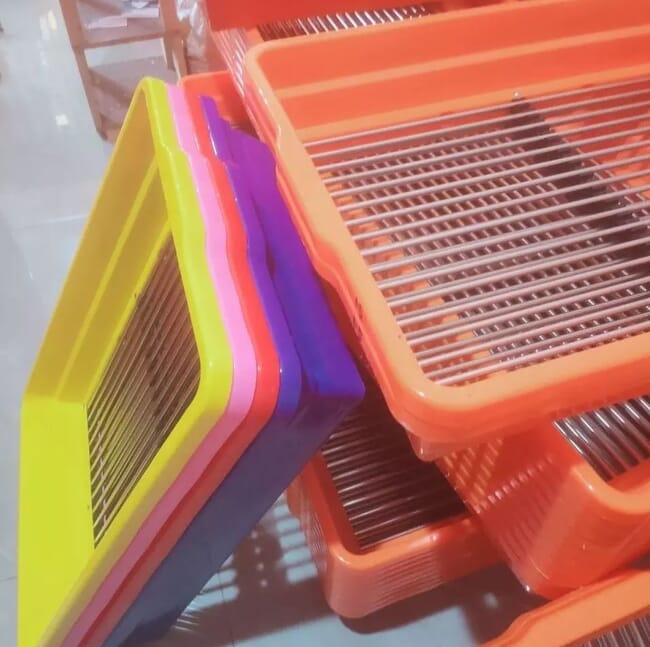
Producers should consider size-grading fingerlings and putting them into groups to become more efficient © Ceonaraqua
Nonetheless, single-batch stocking makes sense in some situations. Advantages can involve more efficient feed conversion due to reduced size-related aggression and competition among individuals, better control over inventory, greater ease in monitoring production data such as growth, mortality or feed conversion for management purposes and a more uniform product for the marketplace. Aggressive, competitive or cannibalistic aquatic species typically require single-batch production systems, but with rigorous grading to minimise size differences during several phases of the production cycle. In these situations stringent size grading can increase harvests by up to 25 percent.
To take advantage of this phenomenon and improve economic efficiencies, facilities should be designed or modified to accommodate the similar-sized groups (larger, smaller and even intermediate) of fish resulting from each grading event. At each phase of the grow-out cycle, larger and smaller size groups must be maintained separately, although it may be possible to combine some groups into an intermediate size class (the smallest of the large ones and the largest of the small ones, as it were) following subsequent grading later in the cycle.
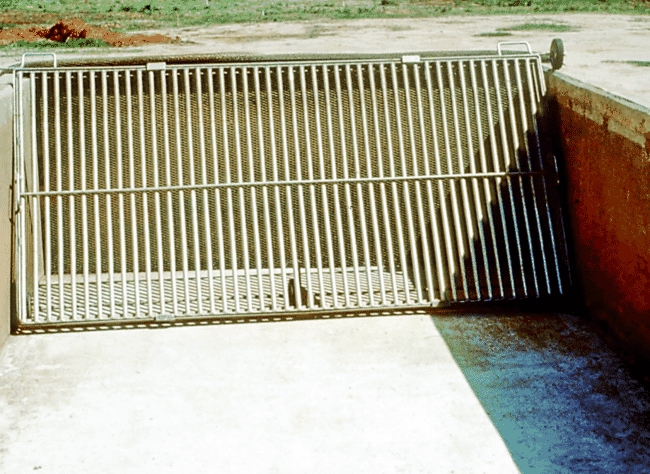
Bar graders can be used to “comb out” harvestable sized individuals at regular intervals during the farm cycle
Examples of single-batch culture for carnivorous species with one or more size grading events include hybrid striped bass, walleye, Pacific threadfin, largemouth bass, groupers, sciaenids and salmonids. With proper facility design and management, even if only a single cohort of animals is initially stocked, several harvests of size-graded animals may result, improving both yields and cash flow.
Even without grading, once animals that were stocked in a single-batch strategy reach a minimum marketable size, it may make sense to undertake a partial harvest, freeing up system capacity to allow the remaining stock to continue growing, especially if larger sizes command higher prices. Partial harvests can also be size selective. This can involve seining ponds with mesh sizes that retain marketable animals while leaving smaller individuals to escape back into the pond to continue growing. These techniques are used for some crustaceans, such as freshwater prawns, and many scale-less fishes, such as certain catfish species.
Similarly, in tank or raceway production of scaled fishes with substantial variation in growth rate, bar graders can be used to “comb out” harvestable sized individuals at regular intervals, allowing more space and inputs to be utilised by the remaining fish. However, for delicate species that have poor handling tolerance it may be necessary to forego grading and partial harvests altogether and simply harvest each pond, tank or cage completely in as short a time as possible.
Multiple-batch production
In multiple-batch production two or more distinct size classes are present at any given time, with animals being stocked after each harvest to replace those that have been removed. The primary benefits of multiple-batch stocking and harvesting involve more efficient use of production systems by maintaining day-to-day standing stock closer to maximum carrying capacity, as well as the availability of marketable product at much more frequent intervals. The latter factor was the rationale for the widespread adoption of multiple-batch management practices in the US channel catfish industry during the 1980s, when off-flavour problems could cause an entire pond to be temporarily unavailable for harvest.
Unfortunately, even when a species is not particularly carnivorous or cannibalistic, competition for food often results in problems when mixed sizes are cultured together. When larger fish share the same space as smaller size classes, they may consume more feed than they require, while smaller individuals do not receive sufficient rations for maintenance, let alone growth. Both factors reduce feed conversion efficiency, and insufficient food intake can lead to higher stress and mortality among younger size classes. This is one of the main drawbacks of multiple-batch stocking and harvesting.
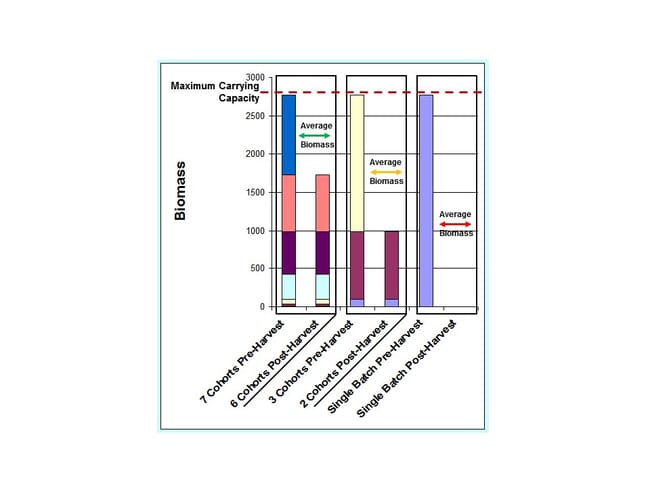
In this case, the maximum carrying capacity is 2800, and the largest size class present is harvested when the total biomass reaches 2750. Even with only three size classes present, the average day-to-day biomass increases substantially over that attained with a single-batch strategy
When mixed sizes are cultured together in the same pond, tank, cage or raceway, methods must be available to remove larger individuals for harvest while leaving smaller ones undamaged, similar to those mentioned above for partial harvests of single-batch systems. An additional requirement involves the availability of fingerlings for stocking throughout the year.
Partitioned systems
Many single-batch facilities can be converted to multiple-batch systems, while avoiding competition between size classes and the need for size-selective harvesting. When culturing aggressive, competitive or cannibalistic species, intensive production systems such as recirculating tanks or flow-through raceways can often be partitioned to allow for different size groups to be maintained side-by-side, effectively resulting in multiple-batch production within a single production unit. As a result of more frequent harvests and re-stocking, this approach allows for the total carrying capacity of the system to be more efficiently utilised on a day-to-day basis. Of course, a suitable partitioning apparatus must not appreciably reduce water flow and circulation. An additional benefit of this approach from the standpoint of economic competitiveness relates to more regular availability of harvestable animals. But some of the same constraints apply as in a mixed-size multiple-batch system: fingerlings and capital must be available year-round.
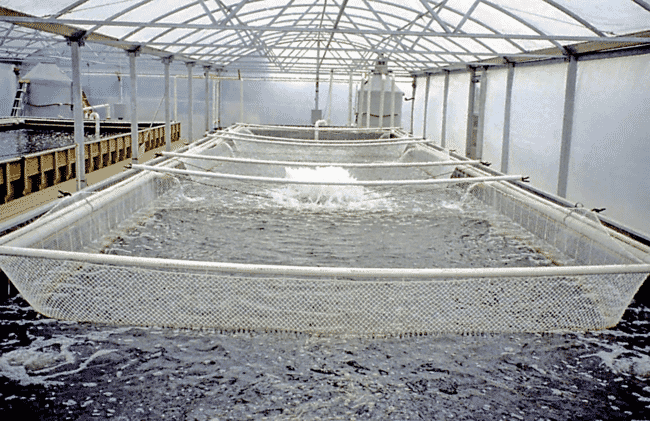
Partitioning tanks can allow producers to culture aggressive, competitive or cannibalistic fish species
Watten (1992) and Summerfelt et al. (1993) explored some of the mathematical relationships that underlie the benefits of partitioning production systems to accommodate distinct size classes. Watten (1992) developed algorithms to optimise multiple stocking and harvest, based on the maximum feeding rate for the system in question, the rearing period, fish size at stocking, growth rate, feed conversion efficiency, and mortality.
Results demonstrated that production per rearing period increased (albeit at a diminishing rate) with an increasing number of harvest/restocking intervals; that is, with increasing numbers of distinct size groups present. Using data based on rainbow trout production, simulation outputs indicated that the increases in production over a single-batch strategy would be 44 percent, 65 percent, 87 percent, 98 percent, 104 percent and 110 percent for 2, 3, 5, 7, 9, and 12 harvest/restocking intervals over a set time period. Clearly, not many single-batch systems can be partitioned into 12 discrete segments, but many would easily lend themselves to two, three or five. Gains in production were somewhat reduced when mortality rate or size at stocking were increased, but the potential for improving yields while using the same infrastructure was impressive.
Summerfelt et al. (1993) presented a biological model allowing intervals between stocking, partial harvests and full harvests to vary independently. They then used the model to compare simulated productivity from single-batch stocking and harvest, concurrent batch stocking and harvest (CBSH - wherein individual groups of fish are stocked at regular periods into a production system and raised to harvestable size in isolation from larger and smaller groups) and concurrent mixed stocking and graded harvest (CMSGH – in which small fish are stocked at regular intervals, directly with larger fish already in the system, and graded harvests of all marketable fish are conducted at regular intervals).
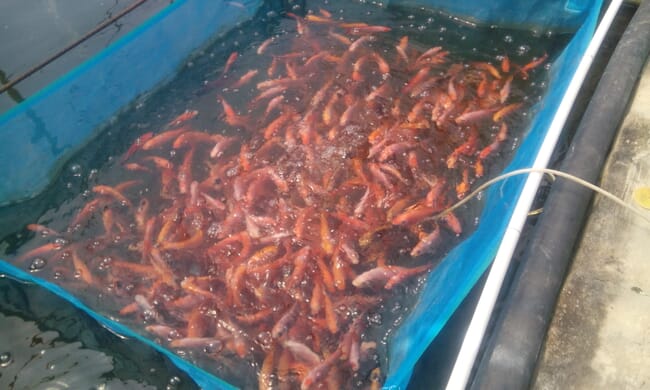
Partitioning aquaculture production systems allows the total carrying capacity to be more efficiently utilised on a day-to-day basis © Nick James
In general, multiple-batch strategies resulted in overall increases of 2 to 3 times the average daily standing stock while producing similar-sized fish for harvest. One assumption of the CMSGH model which may be difficult to realise in real-world scenarios is that fish growth is independent of the presence or absence of fish from other cohorts or larger/smaller fish in the same cohort. Nonetheless, the advantages of multiple-batch production strategies in terms of overall yield were clearly demonstrated once again.
Other considerations
In most production systems and with most aquacultured species, as stocking density increases growth rate decreases, as does the size at which growth slows or ceases. This relationship can be a useful tool for species grown under single-batch stocking but in multiple ponds, tanks or cages. Several groups can be stocked at different densities to allow for staggered grow-out and harvests over a greater period of time, although partial harvests may eventually be required in units with higher stocking rates.
Regardless of stocking arrangements, efficient production strategies require that feed be equitably distributed in every group of animals. Even when multiple phases of production are practiced, with opportunities for grading, size differences can emerge which result in reduced survival and feed conversion efficiency.
When animals of various sizes are stocked together, even more care must be taken to assure all individuals have access to feed. In cage or tank culture, automatic feeders are sometimes used to provide feed at sufficiently frequent intervals to allow for equitable utilisation among all sizes of fish present. Demand feeders are also sometimes used, but these devices tend to encourage the establishment of social hierarchies in some species, wherein certain individuals monopolise the area adjacent to the feeder, effectively blocking access to smaller or less aggressive individuals.
Many of the strategies presented here will require the modification of facilities and production practices, but in almost every instance they will pay for themselves in a short amount of time.


